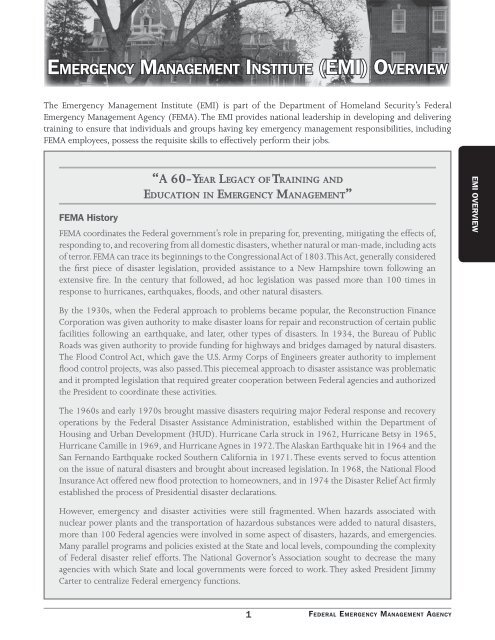enrollment for emi courses - Emergency Management Institute ...
enrollment for emi courses - Emergency Management Institute ...
enrollment for emi courses - Emergency Management Institute ...
Create successful ePaper yourself
Turn your PDF publications into a flip-book with our unique Google optimized e-Paper software.
EmE r g E n c y ma n a g E m E n t In s t I t u t E • 2010-2011 • ca t a l o g of co u r s E s<br />
EmErgENCy mA N A g E m E N T INSTITuTE (EmI) OvErvIEw<br />
The <strong>Emergency</strong> <strong>Management</strong> <strong>Institute</strong> (EMI) is part of the Department of Homeland Security’s Federal<br />
<strong>Emergency</strong> <strong>Management</strong> Agency (FEMA). The EMI provides national leadership in developing and delivering<br />
training to ensure that individuals and groups having key emergency management responsibilities, including<br />
FEMA employees, possess the requisite skills to effectively per<strong>for</strong>m their jobs.<br />
FEMA History<br />
“A 60-Ye A r Le g A c Y o f Tr A i n i n g A n d<br />
ed u c A T i o n in emergencY mA n A g e m e n T”<br />
FEMA coordinates the Federal government’s role in preparing <strong>for</strong>, preventing, mitigating the effects of,<br />
responding to, and recovering from all domestic disasters, whether natural or man-made, including acts<br />
of terror. FEMA can trace its beginnings to the Congressional Act of 1803. This Act, generally considered<br />
the first piece of disaster legislation, provided assistance to a New Hampshire town following an<br />
extensive fire. In the century that followed, ad hoc legislation was passed more than 100 times in<br />
response to hurricanes, earthquakes, floods, and other natural disasters.<br />
By the 1930s, when the Federal approach to problems became popular, the Reconstruction Finance<br />
Corporation was given authority to make disaster loans <strong>for</strong> repair and reconstruction of certain public<br />
facilities following an earthquake, and later, other types of disasters. In 1934, the Bureau of Public<br />
Roads was given authority to provide funding <strong>for</strong> highways and bridges damaged by natural disasters.<br />
The Flood Control Act, which gave the U.S. Army Corps of Engineers greater authority to implement<br />
flood control projects, was also passed. This piecemeal approach to disaster assistance was problematic<br />
and it prompted legislation that required greater cooperation between Federal agencies and authorized<br />
the President to coordinate these activities.<br />
The 1960s and early 1970s brought massive disasters requiring major Federal response and recovery<br />
operations by the Federal Disaster Assistance Administration, established within the Department of<br />
Housing and Urban Development (HUD). Hurricane Carla struck in 1962, Hurricane Betsy in 1965,<br />
Hurricane Camille in 1969, and Hurricane Agnes in 1972. The Alaskan Earthquake hit in 1964 and the<br />
San Fernando Earthquake rocked Southern Cali<strong>for</strong>nia in 1971. These events served to focus attention<br />
on the issue of natural disasters and brought about increased legislation. In 1968, the National Flood<br />
Insurance Act offered new flood protection to homeowners, and in 1974 the Disaster Relief Act firmly<br />
established the process of Presidential disaster declarations.<br />
However, emergency and disaster activities were still fragmented. When hazards associated with<br />
nuclear power plants and the transportation of hazardous substances were added to natural disasters,<br />
more than 100 Federal agencies were involved in some aspect of disasters, hazards, and emergencies.<br />
Many parallel programs and policies existed at the State and local levels, compounding the complexity<br />
of Federal disaster relief ef<strong>for</strong>ts. The National Governor’s Association sought to decrease the many<br />
agencies with which State and local governments were <strong>for</strong>ced to work. They asked President Jimmy<br />
Carter to centralize Federal emergency functions.<br />
1<br />
FEd E r A L Em E r g E N C y mA N A g E m E N T Ag E N C y<br />
EmI OvErvIEw

















